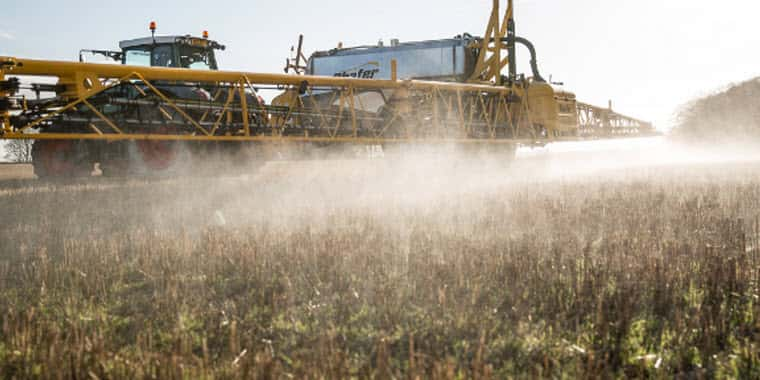Farm groups continue to look for ways to influence the Trump administration’s Make America Healthy Again (MAHA) initiative as they anticipate a new series of policy recommendations set to come out in August.
The Food and Agriculture Climate Alliance (FACA), a coalition of 20 agricultural and conservation trade groups, on Thursday published a report of “MAHA Policy Recommendations” around soil health, conservation, forest management and agricultural innovation. FACA said the coalition offers the report on soil health “as a roadmap to a healthier future — starting from the ground up.”
The National Corn Growers Association (NCGA) also released a survey Thursday of more than 1,000 farmers. Corn growers said they would face higher costs and reductions in crop yields if they were to lose access to key herbicides like atrazine and glyphosate. The MAHA Commission questioned the safety of the two herbicides in its initial report.
“The survey findings reveal high stakes for the MAHA Commission’s next report, a set of policy recommendations expected to be released in August, which could impact a key constituency in President Trump’s base,” NCGA stated.
More than 250 farm groups and agribusinesses wrote to the Trump administration in June requesting a seat at the table as the MAHA Commission continues to move ahead under Health and Human Services Secretary Robert F. Kennedy Jr.’s proposed agenda.
The four co-chairs of FACA from the American Farm Bureau Federation, Environmental Defense Fund, National Council of Farmer Cooperatives and National Farmers Union each highlighted the recommendations as a way to strengthen policies, increase research and ensure farmers continue to have access to technologies going forward.
The coalition laid out a list of 12 suggestions for modernizing and streamlining USDA conservation programs.
FACA calls for supporting “robust funding for financial and technical assistance” through USDA’s conservation programs. “Farmers need financial and technical support to make the adoption and expansion of conservation practices affordable and accessible,” the group stated.
FACA pointed to increased funding in the farm bill’s conservation title, which took funds provided from the Inflation Reduction Act (IRA) and rolled those dollars into the baseline for the Environmental Quality Incentives Program (EQIP), the Conservation Stewardship Program (CSP), the Agricultural Conservation Easement Program (ACEP) and the Regional Conservation Partnership Program (RCPP).
FACA stressed the importance of technical assistance to farmers and noted 25% of conservation funding goes toward technical assistance. Still, USDA’s proposed budget also sought to zero out discretionary funding for conservation technical assistance, though congressional appropriators so far have rejected those cuts.
FACA also called for streamlining approval of new practices for USDA conservation programs. Currently, standards used by the Natural Resources Conservation Service (NRCS) “historically have not kept pace with on-farm innovation, hindering the adoption of newer and potentially more effective practices and technologies.” FACA called for NRCS to update its standards.
“For instance, innovations in cover crop seed mixes, and planting and termination methods often require practice standard updates before they can be eligible for cost-share. Streamlining the years-long update timeline can accelerate progress.”
Looking at agricultural innovation, FACA called for USDA to continue to invest in quantifying environmental outcomes tied to conservation practices, especially in soil health research. FACA also championed the adoption of precision-application technologies and called for incentives to help producers offset those costs and encourage increased adoption.
FACA also championed funding for the Agriculture Advanced Research and Development Authority (AGARDA), a pilot program created in the 2018 farm bill, but also a project that has received only a small amount of funding from Congress over the past seven years.
“AGARDA has the potential to deliver game-changing tools that enhance environmental sustainability, farm productivity, and long-term food security but it must be funded,” FACA noted. “FACA supports reauthorization and full funding of AGARDA to allow USDA to drive high-risk and long-term research to support farming operations.”
FACA also called for a more robust — but streamlined — regulatory process to evaluate both animal and plant biotechnology products. FACA called for a federal definition of biostimulants as well, noting they are “emerging and promising tools that can conserve and replenish soil health and improve water quality.”
Lastly, FACA also wants to ensure farmers continue to have access to a broad range of crop protection tools — insecticides, herbicides and other inputs — “that support conservation goals and a sustainable food system through a responsible regulatory process involving rigorous, science-based risk assessments, including environmental and health reviews.”
In its survey results, NCGA said atrazine and glyphosate “have been thoroughly tested by the Environmental Protection Agency and other regulatory bodies and shown to be safe for their intended uses.”
“These results are in line with what I am hearing in conversations among farmers,” said Illinois farmer and NCGA President Kenneth Hartman Jr. “We are concerned that claims about herbicides in the pending MAHA recommendations could remove access to the tools we need to safely and sustainably produce a crop.”
Hartman added growers hope the president will intervene and ensure the MAHA Commission follows the science and defers to the EPA on matters related to pesticide policy and regulation.
Respondents indicated overwhelmingly — 85% — that weeds are the top pest plaguing their crops and that atrazine and glyphosate were their top two herbicides of choice. By a wide margin, glyphosate ranked as the most important herbicide used by corn growers.
NCGA has said if the pesticides in the initial assessment were to disappear completely, crop yields could decrease by more than 70% due to pests, weeds and disease.
###
DTN


